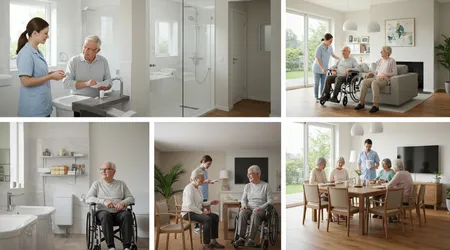How Caregivers Can Support Independent Living at Home

Caregivers can support independent living at home by empowering seniors to maintain autonomy while ensuring safety and well-being.
As populations age globally, the demand for home-based care surges, with many older adults preferring to stay in familiar environments rather than move to assisted living facilities.
In 2025, this trend is stronger than ever, driven by technological advancements, evolving healthcare models, and a cultural shift toward valuing independence.
According to a 2023 AARP survey, 77% of adults over 50 wish to age in place, highlighting the critical role caregivers play in making this possible.
This article explores actionable, compassionate strategies caregivers can use to foster independence, blending practical advice with innovative approaches to create a supportive home environment.
From leveraging smart technology to nurturing emotional resilience, we’ll dive into how caregivers can balance safety with freedom, ensuring seniors thrive at home.
The role of a caregiver is not just about meeting physical needs; it’s about preserving dignity and agency. Caregivers can support independent living at home by adopting a mindset that prioritizes empowerment over dependency.
This means listening to seniors’ preferences, understanding their unique needs, and tailoring support to enhance their quality of life.
Whether it’s helping with daily tasks or coordinating medical care, caregivers must strike a delicate balance offering help without undermining autonomy.
This article will break down key strategies, offering practical examples and insights to guide caregivers in this rewarding yet challenging role.
Why should we limit someone’s potential for independence when we can help them flourish in their own space?
Understanding the Needs of Independent Seniors
Every senior has a unique story, shaped by their health, history, and aspirations. Caregivers can support independent living at home by first assessing physical, emotional, and social needs.
A caregiver might notice Mrs. Thompson, an 82-year-old widow, struggles with mobility but cherishes gardening.
By installing raised garden beds, the caregiver enables her to continue this passion safely. This tailored approach ensures seniors feel heard and respected.
Health conditions like arthritis or early dementia often dictate the level of support required. Caregivers should consult with healthcare providers to understand limitations and risks.
For instance, a senior with mild cognitive decline may need reminders for medication but can still cook independently.
++ Morning Routines for People with Mobility Challenges
Regular check-ins with family or doctors keep caregivers informed, ensuring evolving needs are met without overstepping.
Empathy drives effective caregiving. Understanding emotional triggers like fear of losing control helps caregivers build trust.
By asking open-ended questions, such as “What tasks do you enjoy doing yourself?” caregivers align support with personal goals.
This fosters a partnership where seniors feel empowered, not managed.

Creating a Safe and Accessible Home Environment
Safety is the foundation of independence. Caregivers can support independent living at home by modifying living spaces to reduce risks.
Simple changes, like removing loose rugs or installing grab bars, prevent falls, which the CDC notes cause over 3 million emergency visits annually among seniors.
A caregiver might rearrange furniture to clear pathways for Mr. Lee, who uses a walker.
Smart home technology enhances safety without intruding. Motion-sensor lights illuminate nighttime trips to the bathroom, while smart locks allow caregivers to monitor access remotely.
Also read: The Best Daily Living Aids for Elderly People in 2025
These tools preserve privacy while ensuring security, blending seamlessly into daily life. Caregivers can also teach seniors to use voice-activated assistants for reminders or emergency calls.
Accessibility goes beyond physical changes. Caregivers should organize essentials like medications or kitchen tools within easy reach.
For example, placing frequently used items on lower shelves helps someone with limited mobility maintain self-sufficiency. These thoughtful adjustments create a home where independence thrives.
Leveraging Technology for Independence
Technology is a game-changer in 2025. Caregivers can support independent living at home by integrating smart devices that empower seniors.
Wearable health monitors, like Fitbit or Apple Watch, track vitals and alert caregivers to irregularities. For instance, a caregiver might set up a device to notify them if Mrs. Garcia’s heart rate spikes.
Telehealth platforms connect seniors to doctors without leaving home. A caregiver could schedule virtual check-ups for Mr.
Read more: Guide to Accessible Clothing: Dressing Made Easier
Patel, who dislikes traveling to clinics. These platforms ensure timely medical advice, reducing hospital visits. Apps like Medisafe also remind seniors to take medications, fostering self-management.
Social isolation is a real threat, but technology bridges the gap. Caregivers can introduce video chat apps to help seniors like Mrs. Thompson connect with grandchildren.
Online hobby groups or virtual book clubs keep minds active. By teaching seniors to use these tools, caregivers nurture both independence and connection.
| Technology | Purpose | Example Use |
|---|---|---|
| Wearable Health Monitor | Tracks vitals, alerts caregivers | Notifies if heart rate is irregular |
| Telehealth Platform | Virtual doctor visits | Schedules check-ups without travel |
| Medication Reminder App | Prompts medication intake | Alerts for daily pill schedules |
| Video Chat Apps | Maintains social connections | Facilitates family calls or hobby groups |
Promoting Physical and Mental Well-Being
Physical health underpins independence. Caregivers can support independent living at home by encouraging light exercise tailored to ability.
A caregiver might guide Mr. Chen through chair yoga to improve flexibility, reducing stiffness without strain. Local community centers often offer senior-friendly fitness classes, which caregivers can explore.
Mental health is equally vital. Cognitive games, like crossword puzzles or memory apps, keep minds sharp. For example, a caregiver might play chess with Ms.
Rivera, sparking joy and mental agility. Regular engagement prevents cognitive decline, a key factor in long-term independence.
Emotional resilience ties physical and mental health together. Caregivers can foster this by celebrating small victories, like a senior cooking a meal alone.
They might also encourage journaling to process emotions, helping seniors like Mr. Lee feel in control of their narrative. These efforts build confidence and purpose.
Building a Supportive Social Network
Isolation erodes independence, but connection restores it. Caregivers can support independent living at home by facilitating social ties.
Arranging visits from friends or family, like organizing a weekly coffee with Mrs. Garcia’s neighbors, combats loneliness. These interactions boost mood and motivation.
Community engagement is powerful. Caregivers can connect seniors to local clubs, such as a knitting group for Ms. Rivera, aligning with her interests.
Volunteer opportunities, like reading to children, give seniors purpose. Caregivers might drive Mr. Patel to a library event, fostering a sense of belonging.
Digital communities offer another avenue. A caregiver could help Mrs. Thompson join an online gardening forum, where she shares tips and feels valued.
These connections, virtual or in-person, reinforce a senior’s identity, making independence sustainable and fulfilling.
Encouraging Autonomy in Daily Tasks
Empowering seniors to handle daily tasks preserves dignity. Caregivers can support independent living at home by breaking tasks into manageable steps.
For example, a caregiver might label kitchen containers to help Mr. Chen cook independently, boosting his confidence.
Adaptive tools make tasks easier. A caregiver could introduce a long-handled reacher for Ms. Rivera to grab items without bending.
These tools reduce frustration, allowing seniors to maintain routines. Caregivers should demonstrate their use patiently, ensuring comfort and mastery.
Decision-making is central to autonomy. Caregivers can involve seniors in choices, like asking Mr. Lee to plan a weekly menu.
This respects their agency while ensuring nutritional needs are met. Small choices compound into a sense of control, vital for independence.
Coordinating Care with Family and Professionals
Collaboration amplifies caregiving impact. Caregivers can support independent living at home by partnering with family and healthcare providers.
Regular updates to Mrs. Garcia’s children about her progress build trust. A shared calendar app can streamline communication.
Healthcare coordination ensures holistic support. Caregivers might schedule Mr. Patel’s physical therapy while liaising with his therapist for at-home exercises.
This continuity reinforces independence by aligning professional care with daily routines, avoiding disruptions.
Family involvement can be a delicate balance. Caregivers should mediate when needed, ensuring seniors’ voices are heard.
For instance, if Mrs. Thompson’s daughter pushes for more help than needed, the caregiver can advocate for her mother’s desire to remain self-reliant, fostering harmony.
Navigating Emotional Challenges with Compassion

Caregiving is as much about heart as it is about hands. Caregivers can support independent living at home by addressing emotional hurdles with sensitivity.
Seniors may fear losing independence, so caregivers must listen actively, validating feelings without judgment.
A caregiver might notice Mr. Chen’s frustration with needing help. By affirming his strengths like his storytelling caregivers rebuild confidence.
Analogously, caregiving is like tending a garden: nurturing strengths helps the whole person bloom, even in tough seasons.
Grief or anxiety can surface as seniors age. Caregivers can introduce mindfulness practices, like guided breathing for Ms. Rivera, to ease stress.
If emotions escalate, connecting seniors to therapists ensures professional support, maintaining emotional stability for independent living.
Conclusion
Caregiving is a dance of balance, blending support with freedom to honor seniors’ desire to age in place.
Caregivers can support independent living at home by creating safe, accessible spaces, leveraging technology, and fostering physical, mental, and social well-being.
Each strategy whether modifying a home, introducing a smart device, or encouraging a hobby builds a foundation where seniors thrive independently.
The 2023 AARP survey underscores this desire, with 77% of seniors prioritizing home-based living, a call caregivers answer with creativity and compassion.
By empowering seniors to lead fulfilling lives, caregivers don’t just provide care they unlock potential.
As we move further into 2025, embracing these strategies ensures seniors live not just safely, but vibrantly, in the homes they love. What legacy of independence will you help create today?
Frequently Asked Questions
How can caregivers ensure safety without restricting independence?
Caregivers can install safety features like grab bars or smart sensors while encouraging seniors to perform tasks they enjoy, balancing security with autonomy.
What technologies are most effective for independent living?
Wearable health monitors, telehealth platforms, and video chat apps help seniors manage health and stay connected, enhancing independence with minimal intrusion.
How do caregivers address resistance to help?
By listening empathetically and involving seniors in decisions, like choosing daily tasks, caregivers build trust, reducing resistance while respecting autonomy.
